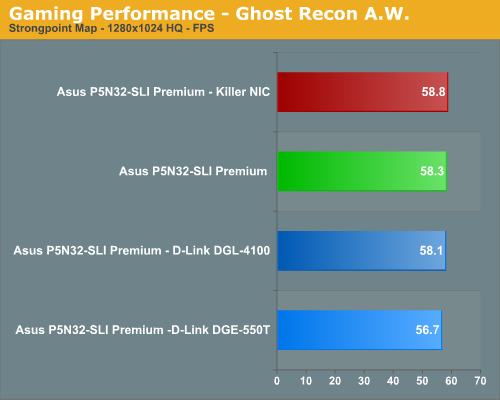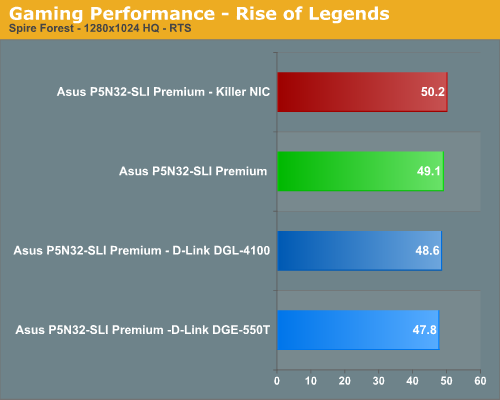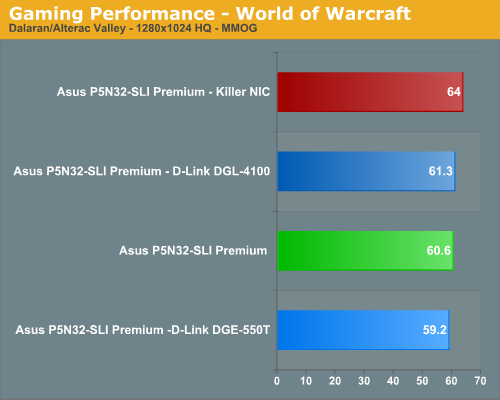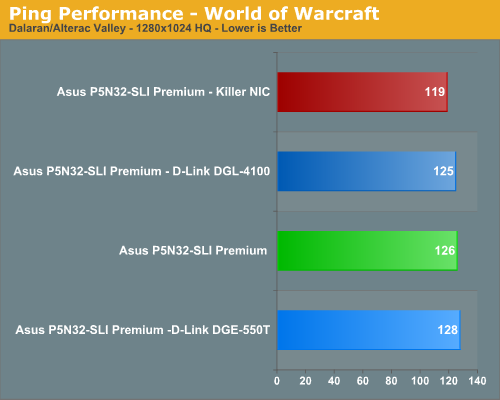BigFoot Networks Killer NIC: Killer Marketing or Killer Product?
by Gary Key on October 31, 2006 2:00 AM EST- Posted in
- Networking
Ghost Recon: Advanced Warfighter
While not the most popular online shooter this game has picked up steam lately with the 1.3 patch. We are playing on the Strongpoint map with a total of 12 players. Our video resolution is at 1280x1024 HQ and we found this game to be very playable at frame rates above 40 fps. The servers we connected with were generally showing ping rates around 45ms to 60ms at the time of connection.

We see a very slight frame rate improvement in this game but nothing that was noticeable during game play. It was difficult to tell any differences in game play between each product and as far as we could tell all systems played the game in a similar manner. If we had to make a choice we would choose the NVIDIA nForce 590SLI NIC as it seemed a tad bit smoother in certain areas.
Company of Heroes
Company of Heroes is one of our favorite RTS games around the office. We are playing the Lorraine map in one versus one player mode. Our other test party hosted the game and we found their system configuration to be nearly identical to ours. Our resolution was set to 1280x1024 with all options on high except for AA. This game is very playable with frame rates above 35 fps in multiplayer action.

Bigfoot Networks stated to us early on not to expect any measureable performance differences in the majority of RTS games. Sure enough we did not see any improvements although the Killer NIC did score a little higher than our D-Link solutions. Once again, we did not notice any real differences in game play between any of the products. We actually tried the Killer NIC in APP mode and were greeted with basically the same level of performance.
Rise of Legends
This game was released a few months back and like most real time strategy games is very CPU intensive but still offers a very visual experience. In order to experience the game properly you need a fast CPU, very good memory subsystem, and a decent GPU to play at the higher resolutions. This is one game that seems to have the perfect recipe for the Killer NIC. We are playing the Spire Forest map with Vinci versus Vinci. We generally found the game to be enjoyable with an average frame rate above 40 fps.

Although BigFoot Networks had stated most RTS games will not show any improvements we see a slight increase in frame rates with this game. We have to temper our results with the fact that there was not any noticeable difference in game play between the various products once again. In a blind performance test, any setup could have won for the most enjoyable game play experience.
World of WarCraft
WoW is the largest and probably most enjoyable MMO we have played and is a favorite amongst many of our staff members. This is another title that BigFoot Networks has explicitly stated will show performance improvements and is one that is mentioned in most of their marketing materials. We logged in at several different times that range from Wednesday morning to late night Saturdays to ensure we experienced a wide variety and number of players on the server. We started in the Dalaran Ruins and traveled to the Alterac Valley battlegrounds doing our best to battle the same creatures with each character.


We see about a 4% increase over our other products in frame rates. WoW is basically capped at 64 fps with dual core systems so it is difficult to determine if the Killer NIC would provide any further frame rate increases with our test platform. We have seen increases quoted in the 10% or plus range in this game so we utilized a 3.4GHz P4 in our test bed and noted a 9% increase in frame rates. The Killer NIC gets a point for increasing frame rates as advertised. Of course anything over 35 fps in this game is very playable so the increases while nice did not really improve our game play.
Ping rates did improve by up to 7% (host system improvements and server variables) and this is where we did notice a difference in game play during the busy test sessions on Friday and Saturday nights. When our area was full of players we did notice smoother game play at times with the Killer NIC. This did not happen when we were basically the only characters playing in certain sections. This game is designed to a certain degree for higher ping rates so there is some balancing that is already done by the server during combat. Overall, the Killer NIC performed almost as advertised in this benchmark.
In order to make sure we were not drinking the Snake Oil we did a blind performance test in WoW with a third party. The third party had no idea their on-board NIC had been replaced with the Killer NIC. The first reaction was a question asking if an additional one gigabyte of RAM had been added to the system or if the video card had been changed. This would normally make for very good publicity and we found it slightly amazing that someone would pick up on the differences in performance so quickly. However, this configuration was a dual core CPU based mid-range system and the user would not be one to spend $279.99 on a peripheral other than a new graphics card. If someone had offered them this card for $50 in order to improve their WoW experience they probably would have jumped at it instead of gasping when told the actual price.
While not the most popular online shooter this game has picked up steam lately with the 1.3 patch. We are playing on the Strongpoint map with a total of 12 players. Our video resolution is at 1280x1024 HQ and we found this game to be very playable at frame rates above 40 fps. The servers we connected with were generally showing ping rates around 45ms to 60ms at the time of connection.

We see a very slight frame rate improvement in this game but nothing that was noticeable during game play. It was difficult to tell any differences in game play between each product and as far as we could tell all systems played the game in a similar manner. If we had to make a choice we would choose the NVIDIA nForce 590SLI NIC as it seemed a tad bit smoother in certain areas.
Company of Heroes
Company of Heroes is one of our favorite RTS games around the office. We are playing the Lorraine map in one versus one player mode. Our other test party hosted the game and we found their system configuration to be nearly identical to ours. Our resolution was set to 1280x1024 with all options on high except for AA. This game is very playable with frame rates above 35 fps in multiplayer action.

Bigfoot Networks stated to us early on not to expect any measureable performance differences in the majority of RTS games. Sure enough we did not see any improvements although the Killer NIC did score a little higher than our D-Link solutions. Once again, we did not notice any real differences in game play between any of the products. We actually tried the Killer NIC in APP mode and were greeted with basically the same level of performance.
Rise of Legends
This game was released a few months back and like most real time strategy games is very CPU intensive but still offers a very visual experience. In order to experience the game properly you need a fast CPU, very good memory subsystem, and a decent GPU to play at the higher resolutions. This is one game that seems to have the perfect recipe for the Killer NIC. We are playing the Spire Forest map with Vinci versus Vinci. We generally found the game to be enjoyable with an average frame rate above 40 fps.

Although BigFoot Networks had stated most RTS games will not show any improvements we see a slight increase in frame rates with this game. We have to temper our results with the fact that there was not any noticeable difference in game play between the various products once again. In a blind performance test, any setup could have won for the most enjoyable game play experience.
World of WarCraft
WoW is the largest and probably most enjoyable MMO we have played and is a favorite amongst many of our staff members. This is another title that BigFoot Networks has explicitly stated will show performance improvements and is one that is mentioned in most of their marketing materials. We logged in at several different times that range from Wednesday morning to late night Saturdays to ensure we experienced a wide variety and number of players on the server. We started in the Dalaran Ruins and traveled to the Alterac Valley battlegrounds doing our best to battle the same creatures with each character.


We see about a 4% increase over our other products in frame rates. WoW is basically capped at 64 fps with dual core systems so it is difficult to determine if the Killer NIC would provide any further frame rate increases with our test platform. We have seen increases quoted in the 10% or plus range in this game so we utilized a 3.4GHz P4 in our test bed and noted a 9% increase in frame rates. The Killer NIC gets a point for increasing frame rates as advertised. Of course anything over 35 fps in this game is very playable so the increases while nice did not really improve our game play.
Ping rates did improve by up to 7% (host system improvements and server variables) and this is where we did notice a difference in game play during the busy test sessions on Friday and Saturday nights. When our area was full of players we did notice smoother game play at times with the Killer NIC. This did not happen when we were basically the only characters playing in certain sections. This game is designed to a certain degree for higher ping rates so there is some balancing that is already done by the server during combat. Overall, the Killer NIC performed almost as advertised in this benchmark.
In order to make sure we were not drinking the Snake Oil we did a blind performance test in WoW with a third party. The third party had no idea their on-board NIC had been replaced with the Killer NIC. The first reaction was a question asking if an additional one gigabyte of RAM had been added to the system or if the video card had been changed. This would normally make for very good publicity and we found it slightly amazing that someone would pick up on the differences in performance so quickly. However, this configuration was a dual core CPU based mid-range system and the user would not be one to spend $279.99 on a peripheral other than a new graphics card. If someone had offered them this card for $50 in order to improve their WoW experience they probably would have jumped at it instead of gasping when told the actual price.










87 Comments
View All Comments
WileCoyote - Friday, November 3, 2006 - link
I said it's too wordy. That means take out words. Are you people for real?Frumious1 - Tuesday, October 31, 2006 - link
That post was too short. Three sentences with no real support to back it up. Lamest comment ever.Look, sorry you have poor reading skillz, but a lot of us are quite educated and like to know the WHY and HOW besides just the WHAT. My first thought was "how in the hell is this product supposed to do ANYTHING for frame rates!?" Gary answered that by looking into the details more than superficially. Oh, sure, it doesn't really deliver -- a 5% increase on a moderately high-end system is pretty silly for a $270 product -- but that it can affect frame rates at all is surprising to me. I now have hope for Windows Vista, at least on the networking stack side of things.
What's really odd is that the review is pretty clearly advising people to NOT go out and buy this "killer" product, because it just isn't that great. If I saw a review on AnandTech that bashed a product without any backing material, I'd feel I was reading something at HardOCP. Well, okay, they back up their complaints sometimes, but their testing methodology is worse than suspect. Remember the Core 2 "launch" reviews where they used a midrange GPU config to conclude that it did nothing for gaming performance?
Anyway, there seem to be quite a few new names on here for this article. Wonder how many are employed by BigFoot? It's like there are a bunch of people bashing Gary for even reviewing the product at all, another group that's bashing him for not liking the card, a third group bashing him for not being able to do a 1 page writeup, and then a few people that think: "nice review; didn't surprise me much with the results, but at least we can now know that Killer can help in certain situations, even if it's overpriced as hell."
I'm sure Gary was tested a lot more than is shown in this article. I've conversed with him in the past, and I'd wager he was pulling his hair out over this article. How many times did you write it Gary? Ten? More? I think you ought to post here and set the record straight, because my bet is that in terms of improving gaming performance the Killer NIC is as good as a NIC is going to get... which means the other NICs from Intel, 3COM, etc. are basically all as good as onboard solutions if that. There's really not much you can do to truly improve performance of a NIC for online gaming when you're looking at maybe 5ms worst case being delay added by the hardware and OS.
As I said above in an earlier comment, it would be nice to have more developers like Jon Carmac around, because he apparently knows how to already perform well without lots of extra hardware. Can't say his games are the greatest, but the Doom 3 engine and networking aspects (client/server architecture) are clearly ahead of most other FPS solutions.
WileCoyote - Wednesday, November 1, 2006 - link
I was trying to keep my comment short, simple, and to the point. I don't need to write a page defending my opinion on something as trivial as a product review. The numbers speak for themselves in this review. And it wasn't so much the quantity but rather the quality - there is little to no structure in the review. That's fact, not opinion. There is a better way to write a review - I've read hundreds of them on Anandtech.I guess my Bachelor's Degree in Anthropology from a well-respected U.S. university doesn't count for much and neither does the successful business I created/own which pays a six-figure salary.
Gary Key - Wednesday, November 1, 2006 - link
Apparently my MBA and the fact I am already retired (at 44 and doing this because I really enjoy it) does not count for very much either. LOL.....
Seriously, I am always looking to improve. How would you change the structure of the article?
Aikouka - Tuesday, October 31, 2006 - link
Being that I run an FTP server that tends to see a decent amount of internal traffic, it actually sounds like a TNIC (or simply making a dedicated server) could actually be beneficial to me. Although, I sure have no desire to pay $300 for that card when I could easily spend the money on a second video card for SLi purposes or such. Also, I know switching from single to dual-core really helped to off-set the issue of FTP uploading on the local intranet. It really won't matter as when I build a new PC next month, I'm simple setting my old PC as a dedicated server to offload those annoying tasks.Also, Mlau, there are some games where "real estate" matters. World of Warcraft is a great example of this and I'm glad that I play the game in 1650x1080, because in certain situations, there's so much junk on your screen (I may call it junk but it actually helps :P), that you need all the extra room you can get. You may be happy in 1024x768, but that gives you no right to vehemently demean people for wanting to play in higher resolutions, which doing so also provides a better quality picture without wasting resources on Anti-Aliasing. Almost all the time, enjoying a game the way the developers designed/envisioned it can be an enriching experience for the gamer.
Gary, your comment about WoW being limited to 64 FPS... I think you may've left Vertical Sync on :D. I can easily get 90FPS on my dated Athlon 64 X2 4400+ with a GeForce 6800GT OC playing in 1650x1080 with max graphics settings. Albeit, I don't get a constant 90FPS, but it can be easily attainable in non-expansive places. So yeah, if your refresh rate on your LCD/CRT was set to 60Hz, you probably would see your game hover around 60-64FPS or somwhere between that and 30FPS. I know I turned VSync off on mine as I couldn't constantly achieve 60FPS, so the game lowered my FPS to about 30 with VSync turned on. Simply turning it off raised me to an easy 45 minimum with no tearing evident. I know that in the Hillsbrad/Alterac area, I would probably get around 45-60 depending on how far into the distance I could see.
Gary Key - Wednesday, November 1, 2006 - link
http://forums.worldofwarcraft.com/thread.html;jses...">Blizzard ResponseHi,
We tried your suggestions during testing and nothing helped. We used both LCD and CRT monitors with vsync off. This was with several different video cards and Core 2 Duo/AM2 X2 processors. The frame rates were always capped to 64 until we switched to a single core processor on either system. We contacted Blizzard directly and they confirmed the dual core bug. The link above has their response on line item 6. Are you using FRAPS to capture the frame rates? If so which version please?
Thanks!!!
goinginstyle - Thursday, November 2, 2006 - link
I downloaded FRAPS 2.81 and sure enough my 4800+ X2 is capped at 64FPS.otherwise - Tuesday, October 31, 2006 - link
You can get an 10/100 ethernet card with a TOE dirt cheap for much less then $300 if you really want one. With most people who actuially need a TOE also demanding 10/100/1000 support, there is a glut of 10/100 TOE NICs.dijuremo - Tuesday, October 31, 2006 - link
You will probably get more out of $300 if you get a hardware raid controller for your system (Areca comes to mind) which will not only provide a speed upin storage, but also redundancy for your system. I know it does nothing for your network performance, but is money better spent which is my point.I considered getting a Killer NIC for my new system, but did not do it because of price, no PCI-Express support (Mobo only has 2 PCI slots used for sound card and HDTV tuner and has 4 PCI Express slots, one used currently for Nvidia 7950GX2), plus performance gains were not that good (I read another review of this card about a month ago elsewhere).
As for the person saying sli/xfire is useless, you are totally wrong. At 1920x1080 (using the LVM-37w3 LCD monitor - 1080p native) you need sli or xfire to have decent speeds to play games with AA and AF. If you don't play games or play at 1280x1024 or less it does not matter, but above that you really need sli or xfire.
I also agree the article was a bit too long and actually more effective that a Lunesta overdose. Not sure if the writer is trying to avoid what just happened to HEXUS where they reviewed an Alienware PC and got e-mail back from the company saying they would not get any more harware because of the bad review...
heated snail - Tuesday, October 31, 2006 - link
I don't mean to be a jerk, and I appreciate any sincere and fact-finding test/review article. However:I'm amazed, was this really a review of a basic hardware item? Because instead it reads like a mini-novel about all the difficulty the testers/reviewers had in doing their job. Is it too much to ask for a more verbally efficient writing style? About two paragraphs briefly acknowledging that this product has been hyped in the media, and acknowledging that testing was a little more difficult than usual... then get straight to the tests on page two and conclusions on page three. I can't believe how long it took to read through this whole thing with its very repetitive descriptions and self-references.